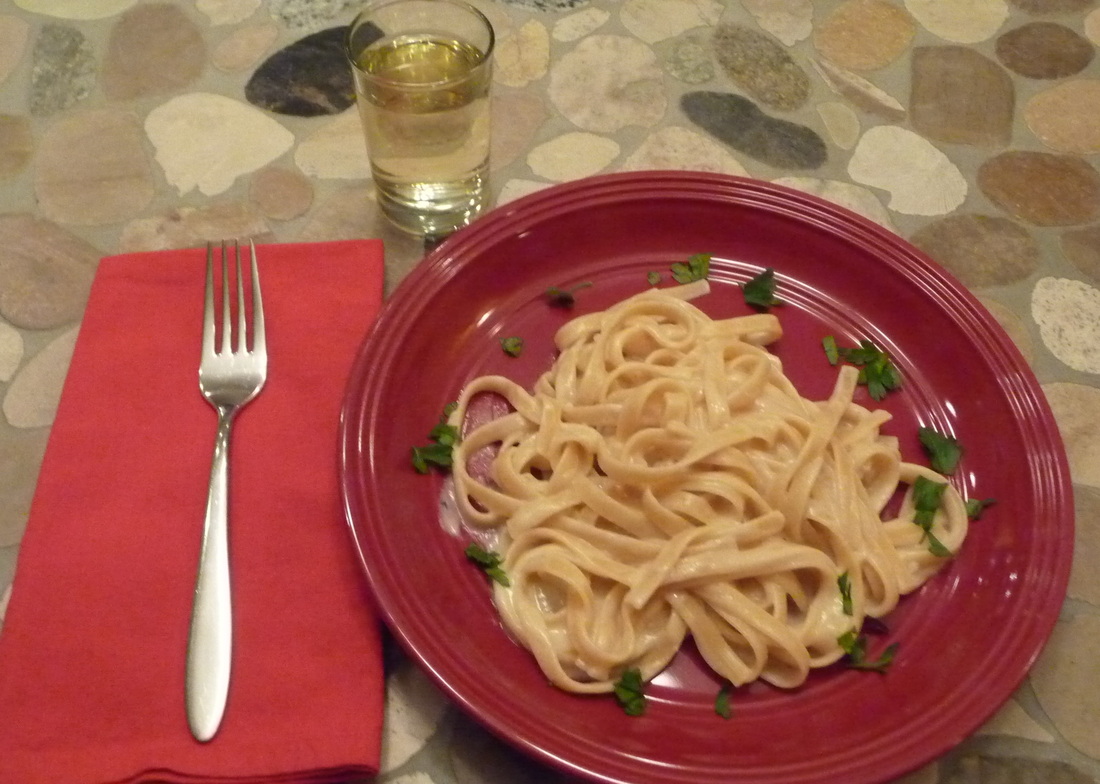| La salsa è tutto, or “the sauce is everything”. That is, the sauce is the most important component. It sounds much more lyrical in French, of course: la sauce est tout; but then, so many things seem to sound better in French! This blog is about sauces – specifically, Italian pasta sauces (salsi in Italian). My primary intent is to introduce two new sauces, but to do so in the context of what I have written previously on this subject. I’ve mentioned before my longtime interest in cooking. I’ve only been blogging for a year, but I have been experimenting with and collecting recipes for many years. Over those many years I’ve “discovered” and come to enjoy and appreciate the rich variety of Italian cooking styles and approaches embedded in these recipes. This web site and these blogs are my opportunity to share these recipes with you. As I’ve also stated before, there are almost as many variation of Italian sauces as there are Italians – and I’ve typically “blamed” Italian grandmothers for this. Consequently, in my childhood home, there was only one meat-based tomato sauce for pasta, regardless of the pasta type – and another meatless version that was served with fish. They were two of the first recipes I posted on this site: Italian Tomato Sauce and Tuna Fish and Anchovy Sauce. I wrote about them last April, recommended them countless times, and will continue to do so. During 2014, I added four other Italian tomato sauce recipes to this online collection that deserve mentioning again: Florentine Tomato Sauce, Spicy Marinara Sauce, Boar Ragu, and Ragu Bolognese. I wrote about the sauce from Florence, also in April. It is prepared primarily with caramelized onions and no meat. The Spicy Marinara Sauce (April) is ideal for serving with fish and seafood; the Boar Ragu (September) is extraordinarily delicious – perfect for very special occasions; and the two blogs I’ve devoted to Bolognese sauce (March and September) should suffice to prove how much I enjoy preparing and serving that one! The recipe for Sugo all’Amatriciana is a new post. This sauce originated in the town of Amatrice, located in the Provence of Rieti in the Lazio region about 90 miles northeast of Rome. As we should expect by now, there is no single recipe for Amatriciana sauce, but it is classically prepared with crushed tomatoes, onion, red pepper, and guanciale (cured pork jowl) or pancetta. This recipe calls for both meats. Since this sauce was not part of my heritage, I cannot make any claim of authenticity. I can state confidently, however, that this recipe is one of my favorites for good reason. | ITALIAN PASTA SAUCES Basil Pesto Boar Ragu Cacio e Pepe Florentine Tomato Sauce Italian Tomato Sauce Italian Cheese Sauce - NEW! Pasta Carbonara Ragu Bolognese Spicy Marinara Sauce Sugo all'Amatriciana - NEW! Tuna Fish with Anchovy Sauce Sugo all'Amatriciana served over bucatini. Grandpa Joe's Italian Cheese Sauce served over fettuccine. Fettuccine Giuseppe, maybe? Great idea, but probably not! |
Alfredo Sauce is another of my favorites. I think it is fair to assume that everyone has heard of Fettuccine Alfredo. Since its most important ingredient is Parmigiano-Reggiano cheese, I always assumed Alfredo Sauce originated somewhere near Parma. In fact, it was created by Chef Alfredo Di Lelio I at his restaurant, Alfredo, in Rome. As one story goes, Chef Di Lelio added Parmigiano-Reggiano cheese to a classic Roman dish called Fettuccine al Burro (Fettuccine with Butter) and served it to newlyweds Mary Pickford and Douglas Fairbanks in 1920. They returned to the U.S., boasted publicly about their “extraordinary” Italian dining experience, and soon Fettuccine Alfredo was being served everywhere in America. It is still virtually unknown by that name in Italy.
I call my version of Alfredo Sauce simply Italian Cheese Sauce (Salsa di Formaggio Italiano). It is the second newly posted recipe. Italian Cheese Sauce is only marginally similar to the original Alfredo Sauce, but (I will submit) equally delicious. My sauce is roux-thickened, and contains sautéed onion, white wine, and Caciocavallo cheese (a sheep or cow's milk cheese produced in southern Italy) in addition to the vitally important Parmigiano-Reggiano cheese. It has become one of my house specialties.
In fact, we serve all the sauces I’ve mentioned here multiple times each year in our household. I hope one or more of them make it to your dining table, too.
Buon appetito.


 RSS Feed
RSS Feed